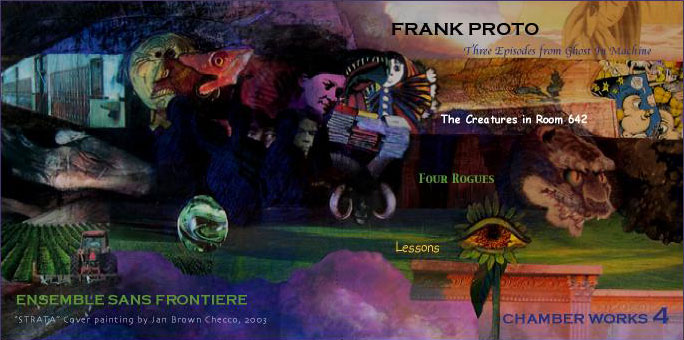
|

|

Chamber Works 4
Featuring
|
Jessicia Walter Voice |
Christopher Philpotts Oboe, English Horn |
Marie Speziale Trumpet |
|
Michael Chertock Piano |
William Platt Percussion |
Frank Proto Double Bass |

Hear Audio Excerpts of the music
See ReviewsNotes by Jonathan Kramer (excerpts)
With this collection of chamber music for double bass and other instruments, Frank Proto continues and expands several ongoing compositional projects. Here, for example, we find him to be a musical portrait painter. Whether it is aimed at the whimsical inhabitants of a school classroom, or mysteriously unidentified rogues, or his own double bass teacher, we find Frank's ability to create musical characters and personalities carried to new levels of vividness.
We also find Frank showing us, in wonderfully new ways, how the double bass can be an integral part of a chamber ensemble. The bass is not all that common in chamber music, and when we do hear it, it is more often than not treated as a somewhat faceless bass voice. But Frank, who understands his instrument better than most composers do, offers us lyricism, excitement, variety, colorful timbres, and rhythmic invention—all things we associate with the double bass in chamber music far too seldom.
And we find Frank to be, as always, an impeccable crossover artist. Equally comfortable in jazz-like and "legit" idioms, both as composer and as performer, he has achieved a genuine and unselfconscious synthesis of what are, for most musicians, two incompatible worlds of sound. Frank has come to view the distinction between jazz and "classical" as artificial. In some of his works (such as Ghost in Machine), he alternates these styles, creating some startling juxtapositions. In other pieces, particularly the recent ones, his crossover art has gone deeper. Now he composes in his own inimitable style, which he forged from these disparate elements. Is this music jazz? No (or at least only rarely). But does it sound like jazz? Indeed it does! Is this music classical? Not really. But does it work in classical ways? Yes, it does! What in Frank's earlier music was a dichotomy of opposites has become an amalgamation, a consistent style that allows him to express himself and his musical ideas effortlessly.
Frank's deeply held conviction that jazz and legit are not different in any fundamental way exemplifies his skepticism of many stark dichotomies, not only musical but also societal and cultural. His revulsion over beliefs in human inequality, for example, is reflected in his large-scale music drama Ghost in Machine (1993), which he wrote with John Chenault. Ghost deals with conflicts between the races, between society's conformists and its individualists, between the haves and the have nots, and between the sexes. To help underline the equality of opposites, Frank's composition freely intermingles television theme music, fanfares, blues, obsessive ostinatos, Ivesian collages, dixieland, swing, and bebop.
See Printed Editions
Click to view or download a PDF sample of:
Three Episodes from Ghost in Machine
The Creatures in Room 642
Four Rogues
Lessons


